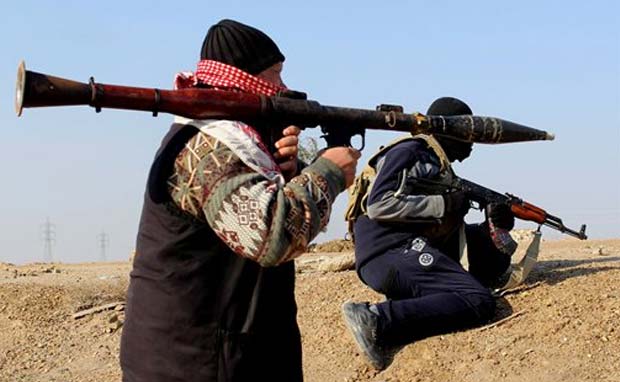
Tajik Government Hypes the Islamic State Threat, Uses it to Control Population
Publication: Eurasia Daily Monitor Volume: 12 Issue: 82
By:

The government of Tajikistan has long sustained a shaky narrative purporting that Central Asia is in imminent danger of being overrun by militant forces. Long menaced by the specter of the Islamic Movement of Uzbekistan (IMU), the government has more recently added a new group to the list: the Islamic State (IS). With numerous Tajikistani citizens now fighting in Syria and Iraq, officials have begun extolling the dangers returning militants could pose to the very existence of Tajikistan.
Only a tiny segment of the population has traveled to Syria and Iraq. Estimates of the number of Tajikistanis fighting in the Middle East vary widely. Even the government agencies cannot agree on a figure. Whereas the Ministry of Internal Affairs announced that 200 of Tajikistan’s nationals have joined the ranks of the Islamic State, in November 2014 the security services put the figure at 300 (News.tj, January 15; RFE/RL, November 21, 2014). One jihadist has boastfully claimed, on the other hand, that there are as many as 2,000 Tajiks living with the Islamic State (News.tj, January 29).
But the government’s heated rhetoric does not reflect these circumspect figures. In December, President Emomali Rahmon described the Islamic State as a “plague of the new century and a threat to global security” (TASS, December 13, 2014). Earlier in 2014, Interior Minister Ramazon Rahimzoda highlighted the dangers that IS poses in Tajikistan. “Only a strong government, which has a firm political will,” Rahimzoda argued, “is able to protect the country from religious conflicts. That is why the struggle against extremism is more important today than ever before” (News.tj, June 20).
In hyping the radical Islamist threat, Tajikistan has taken the lead from its benefactor Russia, which has over 6,000 troops stationed in Tajikistan and guarded its border with Afghanistan until 2005. Moscow officials have consistently emphasized the Islamic State’s threat. Russian Deputy Defense Minister Anatoly Antonov told journalists in March that IS was gathering strength in Afghanistan and setting its eyes on Tajikistan (RIA Novosti, March 5). Foreign Minister Sergei Lavrov echoed this sentiment on a trip to Dushanbe on April 2. Tajikistan, Lavrov argued, is facing “growing threats from the south due to the deteriorating situation in Afghanistan, where groups of Islamic State fighters have already emerged” (Kommersant, April 3). These words came as the commander of Russian forces in Tajikistan, Major-General Yevgeniy Tubol, pledged to strengthen the Russian presence by enlisting 3,000 more soldiers in the next five years (News.tj, April 3).
Tajikistan’s government is using the threat of violent extremism to tighten its grip over the population. In 2014, the Central Asian republic’s authorities arrested 110 extremists; 74 were accused of links to the Islamic State (Radio Ozodi, April 15). Dushanbe has also used the threat of Islamist extremism to legitimate a broader crackdown on religion.
Anyone who shows any sign of piety may be accused by the authorities of constituting a potential threat to social order. Various officials have spoken out against “un-Islamic” clothing in recent weeks. Delivering remarks in Dushanbe on the eve of International Women’s Day, President Rahmon discouraged women from wearing black clothes. Wearing black is “not a characteristic of the Tajik culture and traditions,” Rahmon stated (Radio Ozodi, March 27). At a meeting of law enforcement officers in late March, police chief Abdurahmon Alamshozoda told officers to work actively to counteract signs of radicalism such as the hijab (Radio Ozodi, March 29). Men with beards have also been targeted, with local media documenting numerous cases of police forcing them to shave. The Ministry of Interior has denied any such order exists (Regnum, April 21). Citing the threat of radical Islam, officials in one district in the south of Tajikistan have transformed 50 unofficial mosques into cultural centers (Radio Ozodi, April 21).
However, such clumsy, heavy-handed tactics play into the hands of the extremist movements. Tajik jihadists are now using these incidents to reinforce the idea that Muslisms are under attack in Central Asia. Although many of their propaganda videos focus on the positives of living in the “Islamic State” (caliphate), in some of the videos jihadists from Tajikistan criticize the secular policies of the regime in Dushanbe (Odnoklassniki, August 14, 2014). In one video, a Raqqa-based militant calling himself Umar Hodis Jihod declares that the “Tajik regime is kufr [non-believer]. They unveil our women and force our men to shave. They [government officials] do not pray, yet call themselves Muslims” (Odnoklassniki, December 18, 2014).
The Tajikistani government’s repressive response does not seem to have stemmed the flow of jihadists to Syria and Iraq. Reports of its citizens moving to fight in the Middle East appear on a daily basis. Instead, state policy has left many devout Muslims disillusioned with the state of affairs. Yet, despite having their freedoms encroached upon, most are unlikely to join the extremist movements. The extremist threat will probably remain minimal; for most Tajik militants, their trip to the Islamic State is one-way affair.




